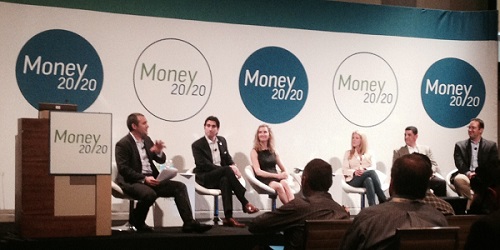
The march towards a new generation of marketplaces was clearly in evidence this week in Las Vegas, as the 4th edition of Money2020 attracted a huge, 10,000+ person ecosystem of financial players that all want a piece of the new world of marketing, commerce and logistics.
In the new era, marked by mobile-based services, Uber and Apple Pay have shown the way for new payment processes: the former by tying together geolocation and an e wallet; the latter by signing up thousands of merchants to accept simplified payments on iPhones.
These companies plus Google, Facebook, Amazon, Microsoft, Groupon, eBay, Twitter, Living Social and Foursquare have been among the dotcom and tech giants exploring the utilization of payments as part of a new breed of “transaction marketing.” Loyalty based plays such as Cardlytics, Edo Interactive, FiveStars, Belly and MOGL are also vying for a piece of the action.
What can be said is that everyone is evolving towards becoming some type of marketing integrators or platform. And services that are geared towards millennials need to get there quicker: millennials won’t do anything that isn’t geared around their phones.
Behind the scenes, payment tech has actually been underpinning advances in business and social processes and lifestyles for generations – perhaps, in modern times, since Amex transformed from a pony express delivery company to a traveler’s cheque company. As recently as the 1980s, we saw how MCI’s revolutionary Friends and Family plan transformed MCI into a long distance giant.
The new generation of mobile-based, wallet-oriented payment services — combined with Internet of Things connectivity and biorhythm user authentication — will be triggering on demand services, promotions, loyalty, credit, loans, delivery/pickup, social media/reviews and back office features such as payroll.
As a show, Money2020’s growth has been spectacular. But in its 4th year, some wondered whether the Money2020 ecosystem has grown too fast too soon, and that “winter is coming” after a year that culminated in the launch of Apple Pay; the expected rollout of two IPOs; and major buy-ins from the dot com giants.
In truth, the industry’s not an overnight success – and the technology still needs to catch up (i.e. phone batteries that can stay powered up). Apple Pay and other mobile payment services have had modest growth in actual usage; First Data’s IPO was smaller than expected; and the loyalty programs have had trouble scaling merchants. In fact, there is real pessimism about Square’s upcoming IPS; and there’s been some retreat by the dotcoms, many of whom have realized that their role is less in banking and payments than in big data and marketing analytics.
Bain Capital Ventures Managing Director Matt Harris noted that all this talk of the “winter” amount to “nothing.” The opportunities are as rich as they’ve ever been conceived, he said.
In fact, everyone should hurry to assume their parts in the ecosystem. All the trends point to 2016 as the mobile payment industry’s probable tipping point. eMarketer’s Bryan Yeager suggests that mobile payments will grow 3x over 2015 – from $8.7 billion to $27.1 billion.
Banks, of course, are widely assumed to be the most vulnerable to disruption in the new environment. But at Money2020, they showed that they plan to fight back, while leveraging an enormous volume of customers that give them a headstart. Chase, for instance, has 94 million debit/credit card accounts. CEO Gordon Smith, in a keynote, said he’ll be able to preload all these accounts by mid -2016 with Chase Pay: a comprehensive new platform that lets customers pay for goods in store, online, over the air, or with a camera in app.
Capital One, similarly, has come out with Spark Business, a new SMB platform that takes an agnostic approach towards single source banking as it builds in analytic services, management features such as accountings, payroll and benefits. “Banks (only) solve banking problems,” noted Cap One’s Brian McNulty. “They aren’t developing for SMBs, they are going up from consumers, or down from corporate.” The new platform is “more powerful for adding more connections and partners,” he said.
The POS leaders also intend to fight back against the new breed of cloud-based providers. They’ll leverage their existing customer base – VeriFone, for instance, has 90,000 taxi and gas station screens around the world. Taxi cab users in Las Vegas, for instance, can opt to pay $3 to make a credit card payment, and receive a print out of local promotions at the same time.
But VeriFone will also work to add new capabilities, and open app stores that give them a new revenue stream for every kind of service. Its rivals in the POS terminal business – namely First Data’s Clover and Poynt – are also building App stores.
“The industry is on the cusp of something historic,” noted PayPal CEO Dan Schulman, who notes that PayPal has 107 million account holders around the world. “We can take basic transactions and make them faster, easier, more secure and most importantly, less expensive. We can truly democratize money. (We can) rethink what financial services can be in world of mobile and software. It is not (just) about tapping a phone or swiping a card. It is much more profound than that.”
This is a special contribution to Local Media Watch by former BIA/Kelsey VP and CHief Analyst Peter Krasilovsky, who regularly writes at Localonliner.com. Peter is moderating a session on The New Marketplaces with executives from Microsoft, Groupon and The Cardlinx Association at BIA/Kelsey NEXT in December.

This Post Has 0 Comments